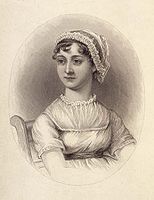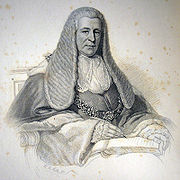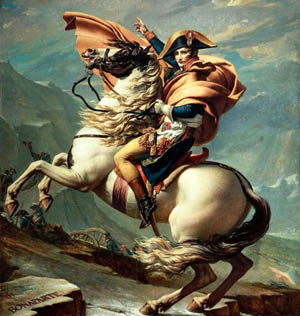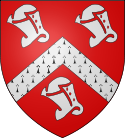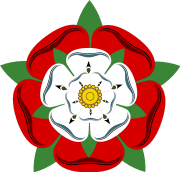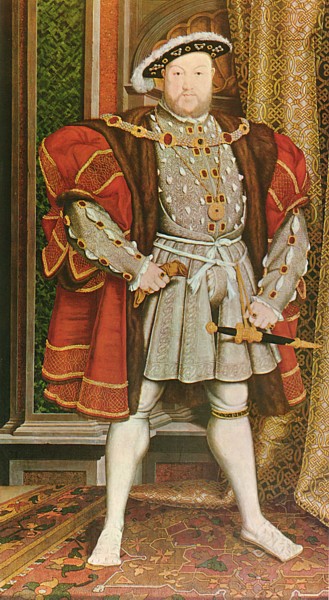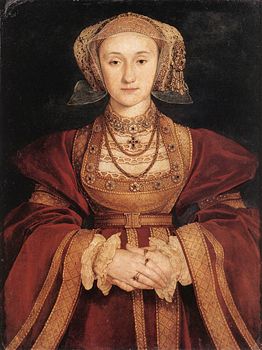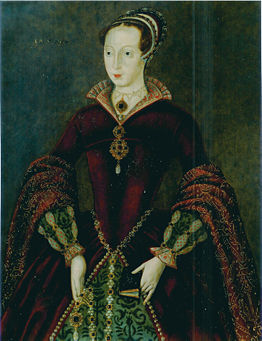Posts Tagged ‘England’
Jane Austen: Her Life and Times
Posted on: November 11, 2008
Who is your Prince Charming?
Edward Cullen from the Twilight series is likely to be the answer to that question. The only other fictional character, who has been compared to Edward Cullen, and perhaps preferred by the older fans is none other than Mr. Darcy from Jane Austen’s famous Pride & Prejudice.
How do you top a handsome, wealthy, yet snooty-at-first English gentleman (or perhaps, how do you top a character played by Colin Firth)? For the longest time no one could, thanks to the genius of Jane Austen. Jane Austen (1775 – 1817) was the original chick lit writer, one of the great literary geniuses of her time, even if she didn’t know it then. And if she did, she was supposedly very modest about it.
When her books came out, they generally got good reviews; however, there were some 19th century book critics who claimed to prefer Charles Dickens’ works instead. Perhaps it was because when they were published, the author’s name was simply “A Lady”, seeing as women weren’t taken seriously as authors then. Or as lawyers. Or, really, as anything other than people whose job it was to take care of children.
Despite that, the Prince Regent, George IV of England, and his daughter, were fans. He kept a set of Austen’s books in each of his residences, Austen found out about that when she was invited to visit the Prince’s London residence in November 1815. While she was there, the librarian hinted that Austen should dedicate the forthcoming Emma to the Prince Regent.
She disliked the Prince, but what could she do? She could hardly refuse that request.
But before her fame grew and her books garnered admiration, she had a very interesting relationship that perhaps gave her inspiration for Pride & Prejudice.
Enter Tom Lefroy
Jane Austen’s background is a humble one. Her father served as a rector of the Anglican parishes at Steventon, Hampshire, which is where the Austen family – which consisted of James, George, Edward, Henry, Francis, Charles, Cassandra, her only sister and closest confident, her father (George) and her mother (Cassandra) resided. Money was scarce, and Austen’s father provided the money by farming and teaching two or three boys who at the time boarded in their home.
When Austen was twenty-one, one of the neighbor’s nephew came for a visit. His name was Thomas Langlois Lefroy (8 January 1776 – 4 May 1869) – but he was simply called Tom Lefroy. He was training as a barrister in London, under his uncle who was a high court judge. Their relationship is explored in the 2007 film Becoming Jane starring Anne Hathaway and James McAvoy.
Tom and Jane were very close and as one of her letters to Cassandra said “I am almost afraid to tell you how my Irish friend and I behaved. Imagine to yourself everything most profligate and shocking in the way of dancing and sitting down together”. It was December 1795 and Austen was working on Elinor & Marianne, later renamed Sense & Sensibility, her first full length novel. It was in the form of letters from one person to another.
Though Tom and Jane may have fallen in love, marriage was impractical, for she had no money and he depended on his uncle’s allowance, most of which he sent to his large family of ten siblings plus his mother and father.
Tom Lefroy left in January 1796 and Austen never saw him again.
Around that time, Austen began working on First Impressions, later renamed Pride & Prejudice; Tom Lefroy is likely to have been the inspiration for Mr. Darcy. The first draft of First Impressions was completed in August 1797, all of Austen’s works were read in front of her family, and this soon became a favourite.
It was when First Impressions was completed that her father made the first attempt to publish one of Austen’s novels. In November 1797, George Austen wrote to Thomas Cadell, an established publisher in London. He asked if Cadell would consider publishing “a Manuscript Novel, comprised in three Vols. about the length of Miss Burney’s Evelina”. Cadell quickly returned the letter marked “Declined by Return of Post”.
Austen may not have known of her father’s efforts. After First Impressions was completed, Austen returned to Elinor and Marianne from November 1797 until mid-1798, revising it heavily and decided to do away with the letter format, going with third person narration instead.
After it had been completed in 1798, Austen started on Susan, later renamed Northanger Abbey, which she completed a year later. In 1803, Henry Austen offered Susan to Crosby, a publisher in London for £10. Crosby bought the copyright and despite promises of early publication, did nothing with it until 1816, when Jane bought it back from him for the price at which it was sold.
The First Move
In December 1800, Rev. Austen announced his unexpected decision to retire from the ministry, leave Stevenson and move the family to Bath. While the older Austens were okay with the move, Jane was shocked to leave the only home she’d ever known.
This move affected her productivity as a writer, for in all the time that she was in Bath she made some revisions to Susan, and started, but never completed The Watsons. In 1804 while still in Bath, Austen received her only marriage proposal from Harris Bigg-Wither. She and Cassandra were visiting their old friends Alethea and Catherine Bigg, and their brother Harris had just finished his education in Oxford and was also at home.
As described by Caroline Austen, Jane’s niece, and Reginald Bigg-Wither, a descendant, Harris was not attractive – he was a large, plain-looking man who spoke little, stuttered when he did speak, was aggressive in conversation, and almost completely tactless. However, Austen had known him since childhood, and their marriage would offer security for her and her family as he was heir to an extensive family estate. And so she accepted. But by the next morning, Austen realized that she had made a mistake – perhaps it was that she did not love him; and withdrew her acceptance.
Austen biographers Claire Tomalin and Park Honan agree that perhaps the reason Austen stopped work on The Watsons is because of her father’s death in 21 January 1805. Her father had gotten seriously ill suddenly and he died quickly.
Jane, Cassandra and their mother were now in a tough financial situation. Though Edward, James, Henry, and Francis Austen pledged to make annual contributions to their mother’s and sisters’ welfare, the Austen women’s living arrangements reflected their financial situation.
For a while they lived in rented quarters in Bath, and then starting 1806 they lived with the newlywed Frank Austen and his wife in Southampton. Then in 1809, Edward offered Chawton Cottage to the Austen ladies. Jane lived there until she died.
1809 – 1816 was a very productive period for Jane. She successfully published four books: Sense & Sensibility, Pride & Prejudice, Mansfield Park and Emma – which was, indeed, dedicated to the Prince Regent. She died in mid-march 1817, with the cause of death tentatively said to be Addison’s Disease by Dr. Vincent Cope in his 1964 retrospective diagnosis. However, the final illness has been said to be Hodgkin’s lymphoma
Henry and Cassandra later published Northanger Abbey and Persuasion in December 1817. Henry contributed a biographical notice, for the first time identifying his sister as the author.
Sales were good for a year, but then at 1820, when all copies had been sold, Jane Austen’s novels went out of print for 12 years. Then in October 1833, Bentley published the first collected edition of Austen’s works, and her books have been in constant print since then.
Scandinavia
Posted on: October 30, 2008
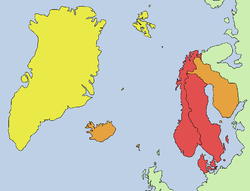
Red: the three monarchies that compose Scandinavia according to the strictest definition; Orange: the possible extended usage; Yellow: the maximal extended usage that takes Scandinavia as synonymous to the Nordic countries.
Wall Street is in tatters. Financial markets everywhere are falling. Many companies are on the brink of becoming bankrupt or already are, such as Lehman Brothers. But nothing is as terrifying as a whole country becoming bankrupt
Iceland has been battered by the current financial crisis. In October, I read that Iceland was on the brink of bankruptcy. And then Kaupthing, the country’s largest bank was nationalized by Iceland’s Financial Supervisory Authority a few days later.
Iceland is not just a block of ice near the North Pole, as one may have thought. No, it’s an entire country, a homeland to 301,931 people. Iceland is also a part of a region of Europe, called Scandinavia.
Scandinavia is a group of countries from which some big things have come. Among them, Ikea, the huge chain of furniture stores around the world; the Icelandic pop singer Björk, who made her debut in The Sugarcubes, an electronica group, and later, became a solo artist; Volvo, one of the safest cars on the market; and, the pop group ABBA.
As far as groups of countries go, Scandinavia – which today consists of Iceland, Norway, Finland, Sweden and Denmark – is a unique one. It was home to the Vikings from 793 – 1066 AD. They were as barbaric a people as any in the earlier centuries; they raided Saxon-England and killed many. You see, they were running out of land. If you were to fast forward about eight centuries, you would see that a Viking daughter would still not be able to inherit anything from her father when he died. Everything went to the sons.
It was a slightly different scenario for the Viking boys during 1000 AD. When a father died, only the eldest son inherited his land. The younger sons got nothing. Well, they needed land to build their houses, right? So, what did they do? The simple solution: steal foreign land. And since England is close to Scandinavia, why not start there?
Over in England, William of Normandy had discovered a whole group of countries that were – gasp – not his. He wanted to conquer Scandinavia and make it his own. Understandably, the Vikings did not welcome him with open arms. After an intense battle however, William of Normandy won, and that was the decline of Viking rule in Scandinavia.
But Scandinavia was not always a united group of countries. Fast-forward again eight centuries, to the time of the Napoleonic War (1803 – 1815) when Sweden and Denmark-Norway fought against each other.
This war was sparked by the French revolution and led by Napoleon Bonaparte. Denmark-Norway were, at that time in union under the same king and they tried to remain neutral. But they had to get involved once their navies were threatened by the British, and they consequently joined forces with Napoleon. Sweden, however, was very active from the start, and very much a part of the war. In 1813, they were promised Norway by the Coalition forces against Napoleon, for joining their Alliance against France.
On January 14, 1814, the king of Denmark-Norway signed the Treaty of Kiel, which gave Norway away to Sweden. However, the terms in the treaty were not acceptable to all and an opposition group led by Christian Frederik, an heir to the Denmark-Norway throne, was formed.
On May 17, 1814 the Constitution of Norway was signed by the opposition group, and Norway declared herself independent, with Christian Frederik as her king. The Swedish king did not accept the idea of an independent Norway, and a war followed from 27 July 1814 – August 14, 1814.
The short battles were won by the Swedish, and the Norwegian king conceded to a peace treaty, which required him to return to Denmark and give up his Norwegian throne provided Sweden accepts the democratic Norwegian constitution and a loose personal union. And so on November 4, 1814, the Norwegian Parliament entered into a union with Sweden.
During the First World War, all the countries in Scandinavia remained neutral; however, the war did have an effect on the economy. It took a hit on Scandinavia, as it did the rest of the world.
Coming back to the present, Scandinavia is today made up of five countries. Yes, five – Denmark, Norway, Sweden and usually, though not officially, Finland and Iceland.
Here’s some handy information on these five countries:

Denmark’s population of about 5.4 million speak Danish. Most of the people there have been baptized Protestant. In 2008, Copenhagen was declared the most livable city in the world by Monocle magazine! The winner’s citation read: “Copenhageners rejoice: your city (and its design) has our gold medal.”

In 2007 Norway had a population of about 4.6 million that spoke mostly Norwegian. However, in some districts, Sámi is an official language, too. The Nobel Peace Prize is presented in Oslo – the only Nobel Prize not to be awarded in Sweden.
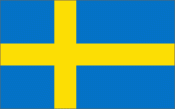
Sweden’s population of 9 million speak Swedish. The Nobel Prizes are presented in Stockholm, seeing as a Swedish man, Alfred Nobel established the Prizes. Sweden is heavily affected by winter. Every year in January; the city of Kiruna is blanketed in the darkness, and actually gets 0 hours of daylight!

Finland’s population of 5.3 million speak both Finnish and Swedish as their official languages. This bi-lingual country makes good use of its 1.8 million saunas. Also it has, 5.2 million mobile phones in use. Nokia, being a Finnish brand, probably had something to do with that.
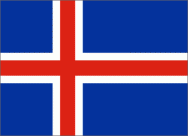
Iceland’s population of 301,931 speaks Icelandic and it is the least populated country in Europe. Despite Iceland’s name giving the impression that it is full of ice and no more, it’s chock-a-block with natural wonders. The midnight sun (apparently there is such a thing and it’s not just a title from the Twilight series) is an amazing light during the night in the summer.
If you wish to find out more about these fascinating countries, you can check out their websites:
Denmark – http://www.denmark.dk/en/
Norway – http://www.visitnorway.com/
Sweden – http://www.sweden.se/
Finland – http://www.visitfinland.com/
Iceland – http://www.icetourist.is/
I must say that the Finland website had the most interesting information, stating some of the unique statistics about Finland.
Scandinavia is very cold, being near the North Pole. Ranging from 5°C to -6°C in just the past few days, it was probably also one of the reasons the Vikings traveled to England, which although cold and rainy, is still warmer than Scandinavia.
Information on the Scandinavian countries from http://goscandinavia.about.com/.
Other info and pictures from www.wikipedia.com.
The Tudors
Posted on: September 23, 2008
- In: History
- 5 Comments
When you think “king” or “queen”, the country that would probably first pop into your mind would be England.
England’s monarchy is not the most scandalous (although it comes pretty close to being so), but it’s certainly one of the longest. It goes all the way back to AD 477 when Aelle founded the kingdom of Sussex. The very first kings and queens were Anglo-Saxons – add some Scottish blood to the mix and you get the modern British.
Perhaps the most famous royal family was the Tudors. The first Tudor King, Henry Tudor the VII, ascended to the throne when he won the Wars of the Roses (1455-87), a series of civil wars in England fiercely fought between the Houses of Lancaster and York. It was not an easy feat – the Wars of the Roses was an intense battle despite having a name that’s all flowery and soft. It was the turning point for England’s monarchy – who ever won it would become the new king or queen of England.
Both the House of Lancaster and the House of York had strong claims to the throne. The Wars of the Roses was made up of three stages (much like a boxing match), with all three stages featuring wealthy and important families battling it out for the throne. The Yorkists won the first round, with Edward IV coming away as the new king.
The two houses had flags with, naturally, roses on them. It was the white rose of York against the red rose of Lancaster. When the Wars of the Roses ended, Henry VII combined both flags, naming it the “Tudor Rose”. The result was the outer part of the rose was red, and the inner one white. You have to wonder that the Yorkists did not object to their rose being smaller.
The third and final round was the beginning of a significant period of time. As it was, the most vital move was off the battle field, Henry VII married Richard III’s niece, Elizabeth of York, thus securing himself the throne. And the Tudor age had begun.
The Tudors are in the House
Things were good for the Tudors; they were now the royal family and had immense power. Henry VII had four children who survived infancy without much fuss.
Henry VII needed to form an alliance with Spain. But how? Well, much like his own marriage, Henry VII arranged a marriage for his eldest son, Arthur, Prince of Wales with Catherine of Aragon, a Spanish princess. However, after being married for four months Arthur died, leaving the throne in the hands of his brother, Henry VIII.
Henry VIII’s first wife was Catherine of Aragon, a Spanish princess. But wait, didn’t Arthur have a wife with the same name? Who also happened to be a princess? Well, Catherine of Aragon, Henry VIII’s wife, and Catherine of Aragon, Arthur’s wife, was… the same person.
You see, Arthur’s good ol’ dad, Henry VII, had married him to Catherine of Aragon in order to ensure an alliance with Spain. But when Arthur died, Henry VII acquired a Papal dispensation that allowed the young Prince Henry (who became Henry VIII) to marry Catherine of Aragon, for how else would they maintain the alliance with Spain? However, Henry VII held back the marriage until after his death.
Henry VIII is one of the most well-known kings of British history. He is known for his tyranny, his six wives, and the fact that he divorced more than half of his wives and was about to execute the last one, Catherine Parr, when he died. Things were hard for women in Tudor times. If they were born into a rich household, their head of house (always a man) would decide who they would marry. It was a sad time, rich people never married for love (unless you were king or queen). Only the poor were lucky enough to have that privilege.
Back to Henry VIII
Catherine of Aragon was the perfect wife – she assured an alliance with Spain, she was regal and an excellent queen, being from a royal family herself. So why did Henry VIII divorce her? The answer: she did not provide him with any sons. In fact all her children but one, Princess Mary (not to be confused with Mary, Queen of Scots), died as infants. The other reason was Anne Boleyn. Yes, that famous queen who stole Henry’s heart and Catherine’s throne.
Before Henry VIII, people were not allowed to divorce, and everyone followed the same religion. Well, if the church did not allow Henry to divorce his wife then he’d make his own church! Yes, Henry changed the laws to favour himself, naturally. In the process, he broke all ties with Rome, as the Pope was the head of church.
He divorced Catherine; however, things were not as smooth as he may have hoped. Catherine was adamant that she was his wife and his queen, no matter what the new laws and church said. Henry married Anne Boleyn in 1333, but until Catherine’s death in 1536 (she was 50 years old, and in much better shape than Henry when he got to that age), she was always a reminder of what Henry had done, and Anne’s rival.
Now that Henry was head of the church of England, he had absolute power, he could do anything. Anne Boleyn found that out when she was executed for treason, incest and adultery along with her brother, George Boleyn, in 1536.
While Henry was married to Catherine and Anne, he had several mistresses who bore his children. Elizabeth Blount had a son, Henry Fitzroy. Mary Boleyn, Anne Boleyn’s sister, is said to have been Henry’s mistress, and bore him two children, Catherine and Henry Carey. Catharine Carey was in Elizabeth I’s court, and her daughter, Lettice, married Robert Dudley, Liz’s master of horse and supposed love.
Once Anne was dead, Henry almost immediately married Jane Seymour. She was his favourite wife, and he was later buried beside her, as she has bore him his only legitimate son. However, she died in childbirth, and so Henry soon was, once again, a single man and free to marry.
The Last Three Wives and the Beginning of the End
At Henry’s command, Hans Holbien the Younger, an acclaimed artist, went around countries near England painting pictures of women eligible for marriage. When he painted a flattering picture of Anne of Cleves, Henry decided that she would be his wife.
This marriage would also form an alliance with a German Duke, conveniently killing two birds with one stone. By now, it was evident that marrying him was not a wise idea, but back then, women didn’t have much freedom or rights, so I suppose Anne of Cleves saw marrying the tyrant King as an opportunity to bring change to England.
Henry saw the painting of Anne and liked what he saw. Then he saw her in person and did not like what he saw. Anne of Cleves was the only wife of Henry’s that got off lucky, she agreed to a peaceful annulment and got the title of My Lady, the King’s Sister and a considerable divorce settlement that included Richmond Palace, Hever Castle, and numerous other estates around the country. Anne stayed in England for the rest of her life.
Henry chose to blame Thomas Cromwell, the unlucky fellow that arranged the wedding, for the unsuccessful marriage, and Thomas was beheaded on 28 July 1540.
The Catholic Catherine Howard was his fifth victim wife. Historians cannot agree on her age, but she was either just 15 or 18 years old when he married her. Thomas Howard, the third Duke of Norfolk, was her cousin and prompted her to marry Henry with the hope that she might convince him to restore Roman Catholicism. Henry fondly called her his “rose without a thorn”. It turned out she had a thorn that cost her her life. This was an affair with the King’s handsome favourite courtier, Thomas Culpepper, while she was married to Henry.
This was typical; Henry could have affairs, but not his wives. Catherine Howard was accused of treason and was executed on February 13, 1542, when she was just either 16 or 19 years old. Her death ruined all hopes of reconciling with the Roman Catholic church.
By the time Henry married his sixth and final wife, he was humongous, the result of many plentiful feasts. A jousting accident opened up an ulcer on his leg which made him smell like he was constantly spraying Stink for Old, Fat Kings on himself. So by that time, he didn’t want someone who would excite and allure him, he wanted a patient nurse. However, Catherine Parr, Henry VIII’s sixth wife, was almost arrested for preaching Lutheran doctrines to him while he was ill. Interestingly, while Catharine Parr was Henry’s sixth wife, he was her fourth husband!
What’s interesting is that all six of Henry’s wives were related to one another. It sure stays within the family, huh?
As it went, Catherine Parr was actually in love with Thomas Seymour, Henry’s brother-in-law from his marriage to Jane Seymour. But of course, what the King says, goes. She was not free to marry Thomas Seymour until the King died. Henry VIII, the tyrant, the womanizer, the murderer and the King died on 28 January 1547 aged 55 and an old man.
After Henry
After Henry died, it was the late King’s great-niece, Lady Jane Grey who came to the throne. Edward VI, Henry’s only surviving son, died at the age of 15 and Henry had declared his eldest daughter, Mary and his second daughter Elizabeth, illegitimate.
Queen Jane’s rule was the shortest in history – she is known as “The Nine Days Queen”. During those 9 days, Princess Mary had gathered sufficient support to ride into London, and the parliament had no choice but to declare her Queen. Jane and her husband, Lord Guilford Dudley, were both charged with high treason, together with two of Dudley’s brothers. Jane was executed in 1554.
Four years after she ordered the death of her cousin, Queen Mary died. Her half-sister, Queen Elizabeth I, was her successor. As it turned out, of all three of King Henry VIII’s children, it was one of his daughters, Queen Elizabeth I, and not a son, who went on to become one of England’s greatest ruler. She died on 24 March 1603, leaving the throne to James VI of Scotland, whose mother was Elizabeth’s cousin, Mary, Queen of Scotland.
But that is a whole other story in itself.
Information on the Wars of the Roses from http://www.geocities.com/Area51/cavern/5123/faq.html
Other information about the royal family and pictures are from www.wikipedia.com and http://www.royal.gov.uk/output/Page1.asp
